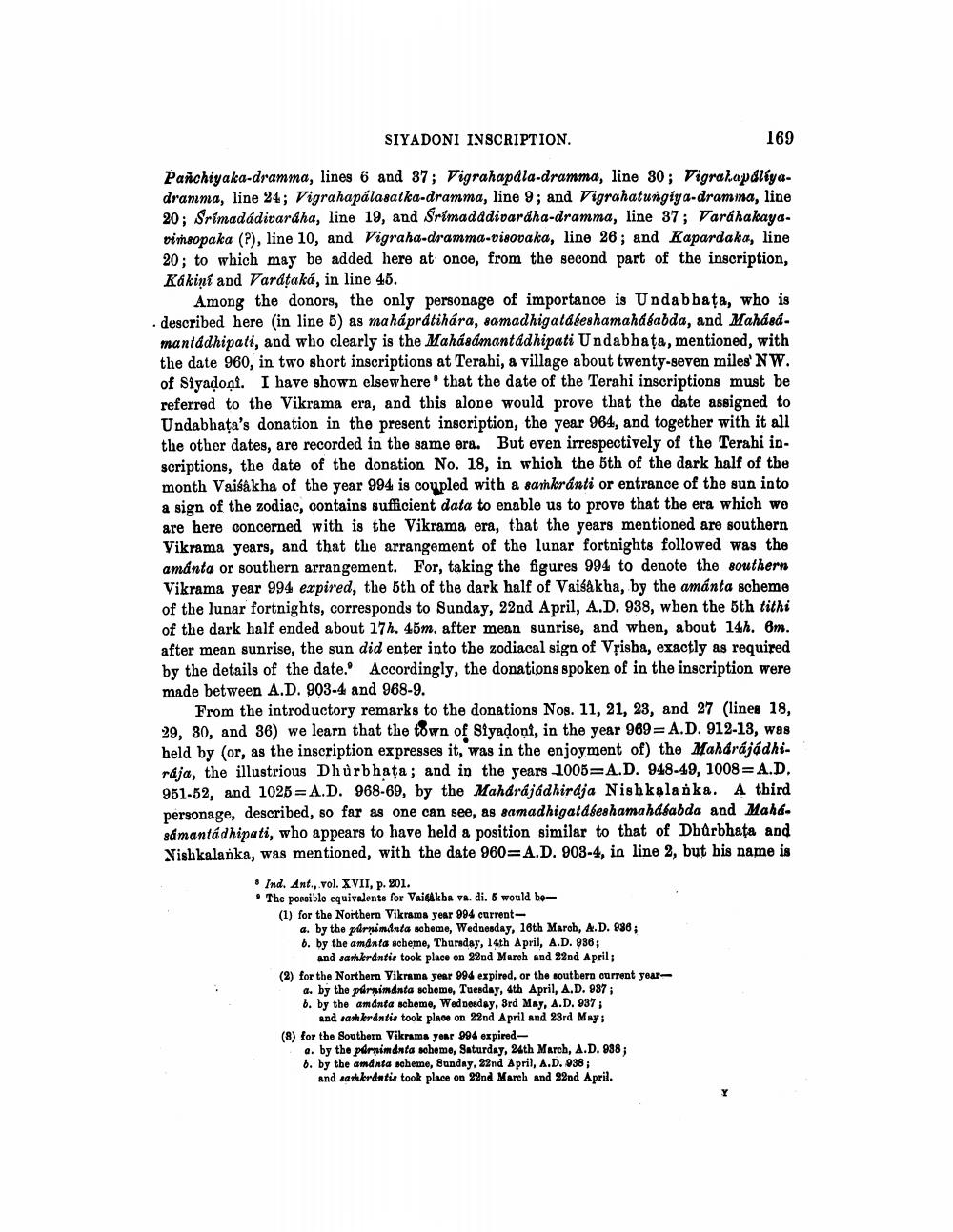________________
SIYADONI INSCRIPTION.
169
Pañchiyaka-dramma, lines 6 and 37; Vigrahapala-dramma, line 30; Vigralapálíyadranma, line 24; Vigrahapálasatka-dramma, line 9; and Vigrahatungiya-dramına, line 20: Srímadádivardha, line 19, and Srimadádivardha-dramma, line 37: Varáhakaya. vimeopaka (R), line 10, and Vigraha-dramma-pisovaka, line 26; and Kapardaka, line 20; to which may be added here at once, from the second part of the inscription, Kakini and Vardtaká, in line 45.
Among the donors, the only personage of importance is Undabhata, who is described here (in line 5) as mahápratihára, samadhigaldseshamahababda, and Mahaedmantadhipati, and who clearly is the Mahásamantadhipati Undabhata, mentioned, with the date 960, in two short inscriptions at Terahi, a village about twenty-seven miles' NW. of Siyadoni. I have shown elsewhere that the date of the Terahi inscriptions must be referred to the Vikrama era, and this alone would prove that the date assigned to Undabhata's donation in the present inscription, the year 964, and together with it all the other dates, are recorded in the same era. But even irrespectively of the Terahi in. scriptions, the date of the donation No. 18, in which the Bth of the dark half of the month Vaisakha of the year 994 is coupled with a sankranti or entrance of the sun into a sign of the zodiac, oontains sufficient data to enable us to prove that the era which we are here concerned with is the Vikrama era, that the years mentioned are southern Vikrama years, and that the arrangement of the lunar fortnights followed was the amánta or southern arrangement. For, taking the figures 994 to denote the southern Vikrama year 994 expired, the 5th of the dark half of Vaisakha, by the amánta scheme of the lunar fortnights, corresponds to Sunday, 22nd April, A.D. 938, when the 5th tithi of the dark half ended about 17h. 45m, after mean sunrise, and when, about 14h. m. after mean sunrise, the sun did enter into the zodiacal sign of Vrisha, exactly as required by the details of the date. Accordingly, the donations spoken of in the inscription were made between A.D. 903-4 and 968-9.
From the introductory remarks to the donations Nos. 11, 21, 23, and 27 (lines 18, 29, 30, and 36) we learn that the town of Siyadoņi, in the year 969= A.D. 912-13, was held by (or, as the inscription expresses it, was in the enjoyment of) the Mahdrájádhirája, the illustrious Dhùrbhața; and in the years 1005=A.D. 948-49, 1008=A.D. 951-52, and 1025 = A.D. 968-69, by the Mahdrájádhirdja Nishkalanka. A third personage, described, so far as one can see, as samadhigaldbeshamahdbabda and Mahá. sámantadhipati, who appears to have held a position similar to that of Dharbhata and Nish kalanka, was mentioned, with the date 960=A.D. 903-4, in line 2, but his name is
. Ind. Ant., vol. XVII, p. 201. . The poroiblo equivalents for Vaikba va. di. 6 would be (1) for the Northern Vikrama year 994 current
a. by the purnimanta sebeme, Wednesday, 18th March, A.D. 988; 6. by the amanta scheme, Thursday, 14th April, A.D. 986;
and sankrantis took place on 22nd Maroh and 22nd April; () for the Northern Vikrama year 994 expired, or the southern Ourrent your
a. by the purpimanta scheme, Tuesday, 4th April, A.D. 987 b. by the amanta scheme, Wednesday, 3rd May, A.D. 937
and sankrantis took place on 22nd April and 23rd May: (8) for the Southern Vikrama year 994 expired
a. by the purnimdata sobeme, Saturday, 24th March, A.D. 938; b. by the amdata scheme, Sunday, 22nd April, A.D. 938;
and sankrantis took place on 22nd March and 22nd April.




